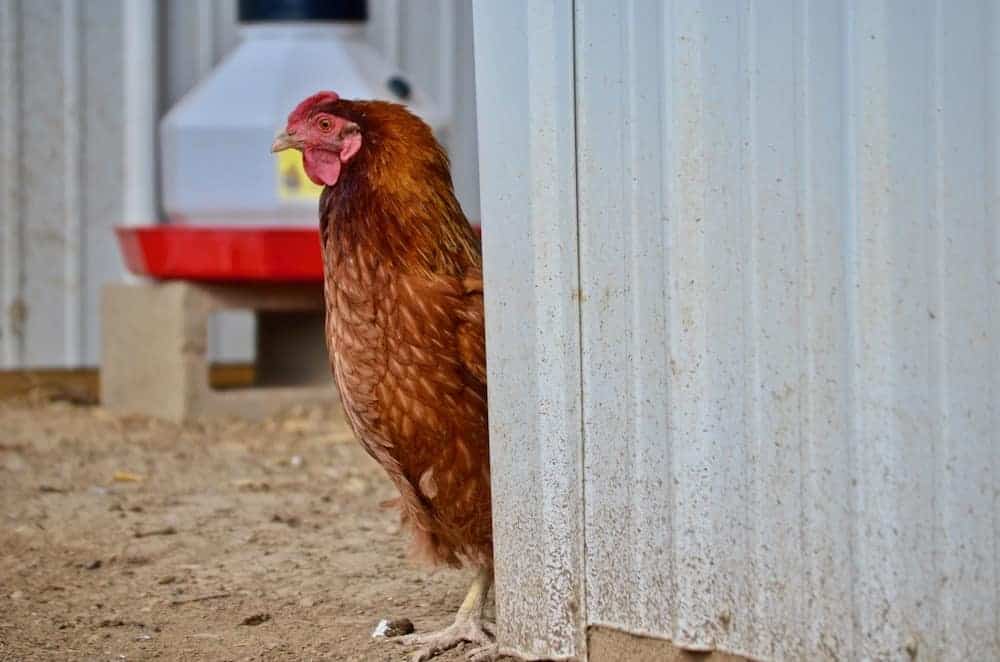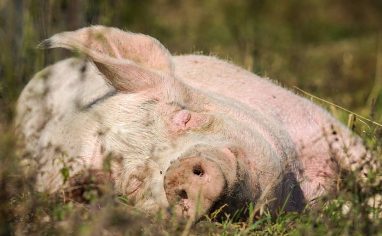
This resource has been partially reviewed and updatedA member of The Open Sanctuary Project’s staff has updated one or more sections within this resource. by a member of The Open Sanctuary Project’s team as of April 26, 2023.
Highly Pathogenic Avian Influenza
For compassionate caregivers of avian residents, highly pathogenic avian influenza (“HPAI”) has presented a dual pronged threat. HPAI is both a serious health threat to birds and with regards to associated legal control measures. We strongly urge that sanctuaries caring for avian residents stay informed about HPAI risks both in their region and more broadly so that they can take appropriate measures to keep their residents protected. This includes implementing a biosecurity checklist as well as associated measures, such as cleaning and access logs to avian residents. Heightened quarantineThe policy or space in which an individual is separately housed away from others as a preventative measure to protect other residents from potentially contagious health conditions, such as in the case of new residents or residents who may have been exposed to certain diseases. measures are also highly suggested while the threat of HPAI persists.
When a new chicken arrives, there are a number of critical steps that must be taken to ensure safety for the incoming resident, existing residents, and yourself!
Take Notes!
Remember to keep good track of all intake information and records of any new resident. Find our Resident Record Keeping guide here.
Identify The Specific Needs Of Incoming Individuals
While chickens, in general, have certain diet, housing, and care needs, you must also consider if the new arrivals require any special accommodations based on their age, breed, sex, health status, known history, or the circumstances of their recent living situation. Each new resident and situation will be different, but some things to consider include:
- If you’re taking in chicks or younger chickens, you will have to learn how to properly care for them in terms of heat, food, and shelter. Very young chicks who were recently debeaked could be in too much pain to eat on their own and may need assistance. You must be shown how to safely feed them with a syringe, dropper, or feeding tube – doing this improperly can result in aspiration and even death.
- Large breed chickens have different care needs than non-large breed chickens when it comes to diet, housing, and flock arrangements.
- Hens rescued from battery cage facilities will require certain modifications to their living space temporarily. They are very prone to piling on top of one another, which can result in smothering and suffocation, so you should eliminate tight spaces or nooks that they could crowd into. You’ll also want to have staff or volunteers around when the hens are going to bed so that they can move hens as needed to ensure everyone’s safety. Additionally, any perches the new hens have access to should be kept low to the ground. There have been multiple instances of newly rescued ex-battery cage hens jumping down from an elevated perch and breaking their leg shortly after their rescue.
- It’s not uncommon for sanctuaries to be contacted about chickens who are severely injured. Individuals rescued from Kaporos, for example, may arrive with fractured wings due to the way they were handled. Individuals rescued as a result of a transport accident could arrive with broken bones or other serious wounds. In the case of a predator attack, they could have small puncture wounds or more extensive injuries (it’s important to note that bite wounds, even if they appear small, can be quite dangerous and almost always require antibiotic treatment). Individuals with serious injury or wounds should be evaluated by a veterinarian immediately.
Adhere To A Quarantine Policy
It is imperative that you implement quarantine protocols to prevent possible disease spread between the new resident and others. Quarantine is critical for all new residents of any species, even if they appear healthy and even if you know exactly where the individual came from! Quarantine procedures protect the rest of your residents (and the humans that care for them) from infectious diseases that may not be producing clinical signs in a healthy-looking arrival – an entire herd or flock could be easily infected, and possibly even killed, by certain infectious diseases. You can read more about quarantine protocols here.
If you’re taking in a whole flock that was living together previously, you can probably quarantine them together since it’s likely that any diseases they have will be already spread throughout the flock, and staying together may put the new residents more at ease. However, if the flock includes a mix of mature large breedDomesticated animal breeds that have been selectively bred by humans to grow as large as possible, as quickly as possible, to the detriment of their health. males and females, they will likely need to be separated to protect females from injury by being mounted by large males. If an individual chicken seems very ill or is behaving oddly, they should be isolated from the others until a veterinarian determines exactly what’s wrong. Monitor the flock to ensure that the current social situation is safe for everyone. Just because they came in together, doesn’t necessarily mean they get along well. If anyone appears to be getting picked on, find a way to split the group to reduce tensions while avoiding anyone having to live alone unless absolutely necessary.
Enrichment Can Help!
Companionship for flock animals such as chickens is very important to their health. While quarantine must be given priority for new residents, it’s important to also consider their mental well-being during this time. An enrichment plan can go a long way in reducing stress, boredom, and loneliness for a quarantined individual, and we’ve got multiple resources that can give you ideas for how to do this. We suggest starting with our resources on social enrichment and chicken-safe enrichment.
Be Careful With Those Eggs!
If you typically feed eggs back to some of your residents, we recommend waiting to do so with eggs from quarantined residents until you have gotten the all-clear from your veterinarian.
Evaluating A New Chicken’s Health
When welcoming a new resident to your sanctuary, it is imperative that you assess their overall health to ensure you are addressing any issues as soon as possible. This is accomplished through initial observations, an intake evaluation, diagnostic testing, ongoing observation, and possibly a veterinarian’s assessment of the individual, especially if the new chicken shows any signs of concerns.
Initial Observations
Whenever you welcome a new resident to your sanctuary, it is crucial that you spend some time observing the individual upon arrival to determine any immediate needs they may have. If you or your staff picked up the individual and transported them back to the sanctuary, this observation process will actually begin before the new resident sets foot on sanctuary grounds. Through thoughtful observation, you may be able to identify signs of concern that warrant immediate veterinary care or further assessment on your part. This part of the intake process will also help determine if an intake evaluation must happen immediately or can wait for the new resident to settle in a little bit. In instances where you are taking in multiple new residents, this process will also help you prioritize individuals who appear to require more urgent assessment.
If you are taking in chickens who look very similar, you must have a system of identifying and documenting individuals while you are getting to know who is who. The use of properly fitting leg bands can be helpful for staff or volunteers who are working on learning everyone’s name and can also be a good way to make sure information is being recorded for the correct individual. When using leg bands, they should be checked regularly to ensure they are not becoming too tight, and you must take care if using them on individuals who are still growing. If the chicken arrived with official identification (such as state issued wing tags or leg bands), it may be a good idea to keep these on for a short period of time if they are not causing issues (especially if the individual arrived from another region that required certain testing or documentation in order to travel into your region), but ultimately we recommend that wing bands be removed since they are an invasive form of identification. Before removing, be sure to record this number (and maybe take a supplemental photo), and keep this information in their record in case you ever need it (such as needing to prove where a certain individual came from). Keep any removed tags with their records.
Prioritizing An Intake Evaluation
It’s important to perform an intake evaluation on all new residents, ideally within 24 hours of arrival, though some may need more immediate assessment. An intake evaluation includes conducting a full health check to evaluate their overall health and to learn more about the individual, as well as gather important information for their permanent record. Be sure to follow quarantine procedures while conducting the intake evaluation. To learn more about the intake evaluation process, including how to prioritize assessing and addressing a new resident’s needs, check out our resource here!
If, for whatever reason, you are unable to perform a full health evaluation shortly after their arrival, you will need to closely observe new residents for signs of concern and take steps to address those concerns appropriately. It is helpful if experienced caregivers physically move the new chickens into their quarantine space – this brief period of holding the chicken can be invaluable, especially if you must wait before conducting thorough health evaluations. By holding the chicken, even for just a few moments, an experienced caregiverSomeone who provides daily care, specifically for animal residents at an animal sanctuary, shelter, or rescue. will be able to identify individuals who may be emaciated, weak, or showing obvious signs of illness or injury. If the new rescues are hens, it’s always a good idea to give their abdomen a quick feel to identify possible reproductive tract issues since they are so common.
An intake evaluation is conducted in much the same way as a routine health check – you should check every inch of the individual, looking for any signs of concerns and providing any necessary treatments. While there are a variety of issues you may find during a new chicken resident’s intake evaluation, there are some health challenges that are especially common in new chickens. These include:
- Respiratory Illness – Watch closely, both during the intake evaluation and during the quarantine period, for any signs of respiratory illness such as discharge from the nares, swelling of sinuses and swelling around the eye, discharge from the eyes, sneezing, open-mouth breathing, audible breathing (wet, raspy, squeaky, etc.), and labored breathing, which may include tail bobbing. Chickens may look dull and tired with puffed feathers, their head may be tucked, and they may have a poor appetite. Respiratory illnesses, of which there are many, are quite common in chickens. Work closely with your veterinarian to determine the cause of the respiratory illness to ensure appropriate treatment.
- Reproductive Issues – Reproductive tract diseases are very common in female chickens, but breeds commonly exploited in industrial egg laying facilities are especially prone to these issues. It’s very important to look closely for signs of reproductive issues such as a distended abdomen or the passing of “lash eggs.” Hens showing signs of reproductive issues should be evaluated by a veterinarian. They can use diagnostic imaging to determine the cause and extent of the issue as well as appropriate treatment options.
- Mobility Issues – You should assess the chicken’s mobility by watching them walk and looking for any abnormalities in their gaitA specific way of moving and the rhythmic patterns of hooves and legs. Gaits are natural (walking, trotting, galloping) or acquired meaning humans have had a hand in changing their gaits for "sport". or shifting of weight when standing. When checking their legs, pay extra attention to their feet and joints (especially their hocks), feeling for any heat, swelling, or crepitus (popping or crunching). Bumblefoot, joint infections, and arthritis are quite common in large breed chickens, so be sure to work with your veterinarian to evaluate any heat or swelling of feet or legs and any mobility issues to determine the best course of action. Sanctuaries are often contacted about chicks with leg issues, which could be the result of a slipped tendon or congenital deformity. Be sure to have the chick evaluated immediately, as addressing issues as early as possible is imperative. Without knowing exactly what’s going on (typically through diagnostic imaging), you may implement interventions (for example hobbling or physical therapy) that actually cause more harm than good.
- External Parasites – Because sanctuaries often take in individuals who may have had their needs neglected, new chicken residents often arrive with some type of external parasites such as various forms of lice or mites, including scaly leg mites. If you do not have experience identifying or treating external parasites, be sure to work closely with your veterinarian or an experienced chicken caregiver. Treatment for mites and lice typically includes a topical treatment, such as Frontline spray or, in the case of scaly leg mites, vaseline, and sometimes a systemic treatment as well. Be sure you know what parasite you are dealing with, as some, such as Red Mites, require extensive treatment of the chicken’s living area as well as treatment of the residents.
- Internal Parasites – Just as external parasites are very common in newly rescued chickens, internal parasites are also quite common. In addition to submitting a fecal sample, be on the lookout for any concerning sign of internal parasites such as bloody feces.
- Obesity – While not always the case, mature large breed chickens often arrive overweight. A severely overweight chicken may be so heavy that they have difficulty standing or walking. These individuals are more prone to developing pressure sores, typically on their hocks and keel. Be sure to watch these areas closely and provide additional padding and protection through additional bedding and/or a padded bandage to protect these areas. It’s important to slowly encourage weight loss through proper diet and to find ways to keep the individual up. If they are unable to stand at all, be sure to work with your veterinarian to rule out any other causes for their mobility issues. If the chicken is unable to stand on their own, they will likely benefit from time in a sling or therapy chair to encourage them to use their legs and to prevent pressure sores.
- Frostbite – While frostbite will be very unlikely in certain climates, if you live in an area where temperatures dip below freezing, you may find that new residents arrive with frostbite or signs that they had frostbite in the past. Be on the lookout for discolored or swollen areas on their comb, wattles, toes, or feet. Depending on how recently they developed the frostbite, toes may be red and swollen and affected areas of the comb or wattles may be paler than normal. Affected areas may then turn purple or even black and become hard and cold. It can take weeks to determine the extent of the damage. If one of your new residents is showing signs of frostbite, be sure to keep them in a warm living space and work closely with your veterinarian. In most cases, pain medication and antibiotics are recommended as well as topical treatment. Chickens can lose part of their combs and wattles as well as entire toes or even their feet as a result of frostbite.
Incoming Testing
If you have not already done so, work with your veterinarian to determine appropriate incoming testing protocols for new chickens you welcome to your sanctuary. While individuals showing signs of concern may require additional diagnostics, there may be certain tests your veterinarian recommends for all incoming chickens. At a minimum, all new residents should have a fecal sample submitted to check for internal parasites. Your veterinarian will be able to recommend dewormingThe act of medicating an animal to reduce or eliminate internal parasites, either prophylactically or in response to illness. treatments based on the fecal results. Be sure to submit another fecal sample 10-14 days after any deworming treatment to evaluate its effectiveness. In order to help prevent the ever-increasing resistance to available deworming medications, it’s important to only use dewormers when necessary and to work closely with your veterinarian if resistance to certain dewormers seems to be an issue.
Your veterinarian may recommend other testing based on the specifics of your region. Certain disease confirmations may require an official report to your local government – if testing for screening purposes only, you may want to have a conversation with your veterinarian about what a positive result would mean for the individual and the sanctuary.
Ongoing Observation
Some health conditions may take time to show outward symptoms. While all residents should be observed closely each day, extra attention should be paid to new residents during their quarantine period to ensure any potential issues are caught and addressed as soon as possible.
Incoming Vaccines
Based on our conversations with the sanctuary community and veterinarians, it seems regular chicken vaccination is rare except in cases where the sanctuary has dealt with specific disease outbreaks. However, it’s best to have a conversation with your veterinarian to see if there are certain vaccines they recommend based on the specifics of your resident population and your region. Most, if not all, available chicken vaccines were designed for use in large-scale agricultural settings where the goal is to maximize profits by reducing mortality rates – not all are appropriate for use in chickens in a sanctuary setting. Also, much of the information on them is based on industry practice, where birds live only a small fraction of their natural lifespan. Make sure you understand both the benefits and risks of any vaccines before implementing at your sanctuary – some vaccines will make residents test positive for the disease, which could have devastating consequences.
Have You Thought About Suprelorin Implantation?
If you care for hens, be sure to familiarize yourself with Suprelorin implants and determine if they are an option for your residents. Not only can implantation give hens a break from the taxing cycle of egg-production, but it can also give them an opportunity to heal from health challenges exacerbated by frequent laying and, anecdotally, has been reported to help chickens live a much longer, healthier life than their non-implanted peers. Read more about Suprelorin implants here. If implantation becomes a regular care practice for your hen residents, don’t forget to incorporate implantation into your incoming hen protocols.
Introducing The Newcomer To Other Chickens
If the new chicken is much less mature than the existing flock, you may want to let them grow up a bit before introducing them to the rest of the flock to ensure their safety during their introduction and to give them time to build up enough immune system strength to handle any disease that might be lurking in the flock. Also consider if a younger chicken will be more vulnerable to certain predators if the flock does not live in a covered aviary.
If you care for multiple flocks of chickens, be sure to think about which flock seems most likely to be the best fit based on the new individual’s breed, sex, age, and personality, taking into consideration all residents in the flock, if caring for mixed-species flocks. And don’t forget that large breed chickens have specific needs when it comes to safe cohabitation!
The New Gang In Town
If you are introducing multiple new chickens at once, this actually tends to improve the odds of an easy introduction to the flock.
Once you’ve ensured that the new chicken is healthy enough to join the resident flock, it can be a good idea to give the chickens time to get used to each other by spending time in separate, but adjacent spaces, especially if introducing roosters to each other (more on rooster introductions below), but in some cases, caregivers choose to skip this step when introducing hens to the flock. If you’d like to give residents time to start getting used to each other through the safety of a barrier, you can set up an “integration kennel” in or adjacent to the resident flock’s outdoor space. The new resident can spend time in this transition space during the day and then move back to their own space in the evening (remember they need to be moved to a safe, predator-proof space overnight). Make sure the integration space has everything they need to be comfortable – food, water, enough space, and shade. Pay attention to the forecast – you don’t want residents stuck out in uncomfortable weather. How long this phase of the introduction process lasts really depends on the individuals. Watch everyone’s interactions closely. If there seems to be tension between the new resident and the rest of the flock, it’s best to wait for this to subside before moving on to the next stage of the introduction process.
When you’re ready to try the new resident with the flock, it’s very important that you monitor their introduction in case you need to intervene! It’s best to conduct the introduction outdoors so that residents have ample room to get away from each other if needed. There may be minor fighting at first, as everyone figures out their place in the pecking order, but as long as no one is getting injured or overdoing it, it’s generally best to let them sort things out for themselves. However, if things get out of hand, you’ll need to break up conflicts quickly. Hens may peck at the new hen or chase her, and in some cases, hens will have an altercation that involves jumping and kicking. When introducing a new hen to a rooster, he may quickly mount her or spend time showing off for her. In some cases, he may intervene in altercations between the new hen and other hen residents and may then chase away the new hen. Even if things appear to be going well, be sure to provide lots of supervision to ensure everyone is getting along. Some individuals, situations, or areas of the living space may result in more tension than others, so just because everyone is getting along well outside soon after the new resident arrives, that does not mean that there will not be an altercation later on (possibly at meal time or if the new resident tries to enter the indoor space).
Pay Attention To The Weather!
It’s always a good idea to pay attention to the forecast when planning introductions, but because large breed chickens are prone to heat exhaustion, you should avoid conducting their introductions during hot weather.
Other good techniques to help the chickens get along include giving them distracting treats like hanging a cabbage from a string, offering new loose foliage to peck through, ensuring plenty of open space in the roost and where the birds eat and drink (especially ensuring equal food and water access), and rearranging the coop when introducing the new resident which could make residents briefly less territorial and may also offer a bit of a distraction as residents explore the rearranged space. If the residents are having trouble with each other, it tends to resolve over time, so don’t give up hope! It may take a few introductions before they all get along.
Sometimes newly introduced residents will get along just fine during the day when they have more room to spread out and avoid each other, but will show signs of discord when closed in for the night. Pay close attention to how everyone behaves after being closed in for the night – if the new resident appears anxious or other residents start pecking at them, offer the new chicken a separate sleeping space (preferably within or adjoining the flock’s living space) – just make sure they have a safe place to roost and that other residents cannot fly into this space.
Nighttime Introductions
While some people recommend introducing new residents at night when everyone is asleep, we feel strongly that all introductions should be supervised and, therefore, advise against this practice. Though it may work for some individuals, there is also the possibility that the new resident will not be welcomed and will have no means to escape from the other chicken residents. Even if you plan to check on them early in the morning, we just don’t think it is worth the risk of having residents in a situation where they are trapped with potentially territorial or confrontationalBehaviors such as chasing, cornering, biting, kicking, problematic mounting, or otherwise engaging in consistent behavior that may cause mental or physical discomfort or injury to another individual, or using these behaviors to block an individual's access to resources such as food, water, shade, shelter, or other residents. residents.
Rooster Introductions
There are a lot of misconceptions when it comes to roosters, in general, but especially regarding whether or not they can safely live with one another. The short answer is, they can! However, successfully introducing roosters to one another can take a bit more planning and patience than introducing a new hen into an established flock or introducing a rooster to a flock of hens. If you are planning on conducting rooster introductions, be sure to check out our resource on Maintaining Healthy Rooster Flocks, which contains lots of tips about the introduction process!
With all introductions, monitoring their first few days together is especially critical to make sure everyone is getting along. You may need to offer additional food and water sources away from where the flock typically eats and drinks if the new chicken is getting pushed away or seems wary of the others. A chicken who is getting bullied or is very fearful may spend much of their time hiding – while an adjustment period is to be expected, a chicken who is constantly hiding or being bullied should be offered other accommodations, at least for now. Some introductions take a few tries, so it may be a matter of going back to the integration kennel phase and seeing if everyone can get used to each other. However, if it seems like the chicken will never be fully accepted into the flock, it would be better to try them with another flock (if you care for multiple flocks) or create a second flock with a few individuals who get along well with each other, being careful not to separate bonded companions. A flock with a constantly bullied or fearful chicken is an unacceptable living situation for the individual chicken.
It may seem like a lot of extra steps than just sending a new chicken into the coop, but if you follow the above guidelines, your new friend will have a much greater chance at a happy, healthy life with you and the flock!
What Does ‘Unacceptable’ Mean?
At The Open Sanctuary Project, unacceptable means that we cannot condone (or condone through omission) a certain practice, standard, or policy. See a more detailed explanation here.
SOURCES:
The Farm Sanctuary Animal Care Guide for Large Breed Chickens
How Do I Introduce New Chickens Into My Old Flock? | My Pet Chicken (Non-Compassionate Source)
Non-Compassionate Source?
If a source includes the (Non-Compassionate Source) tag, it means that we do not endorse that particular source’s views about animals, even if some of their insights are valuable from a care perspective. See a more detailed explanation here.








